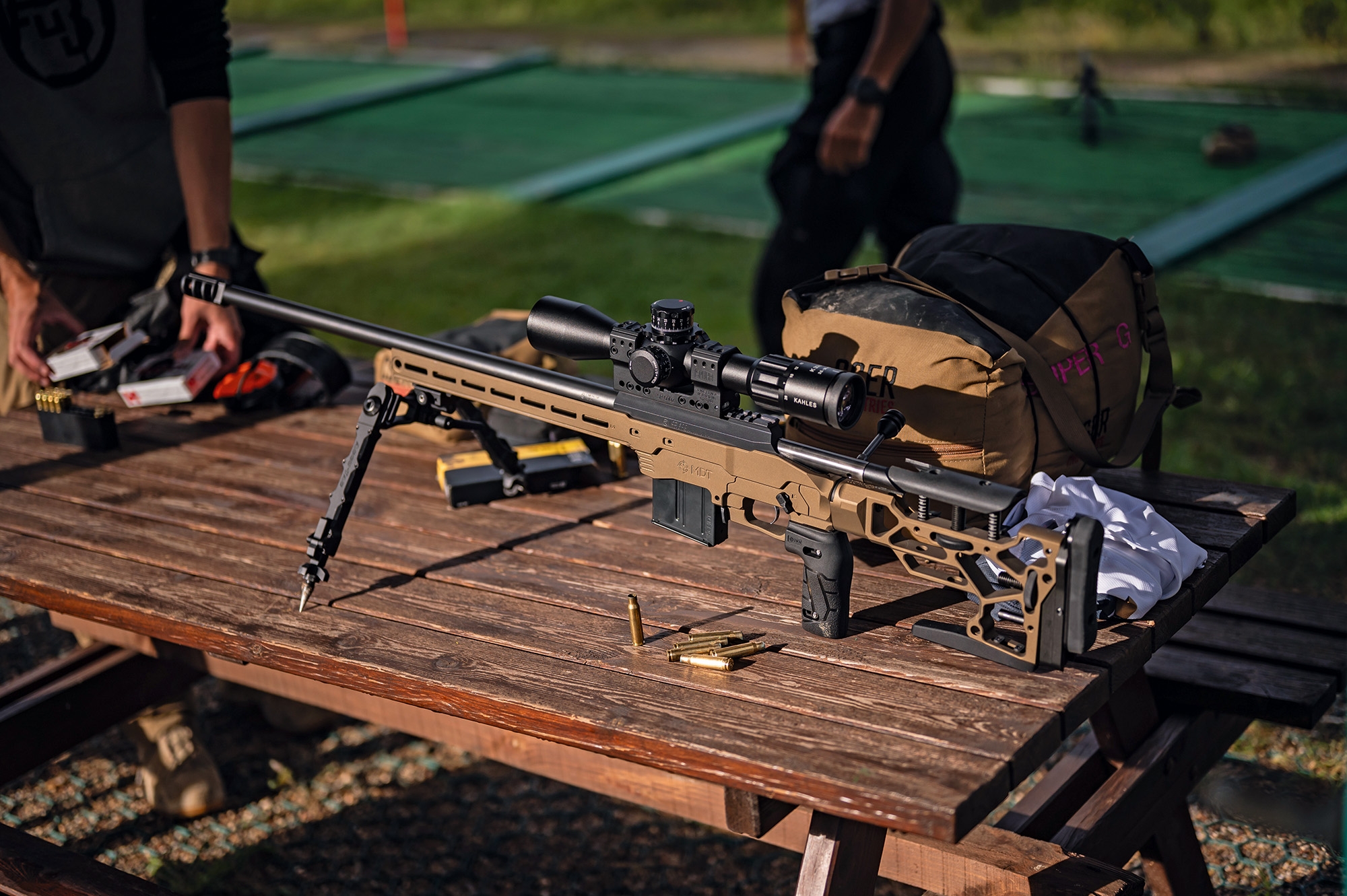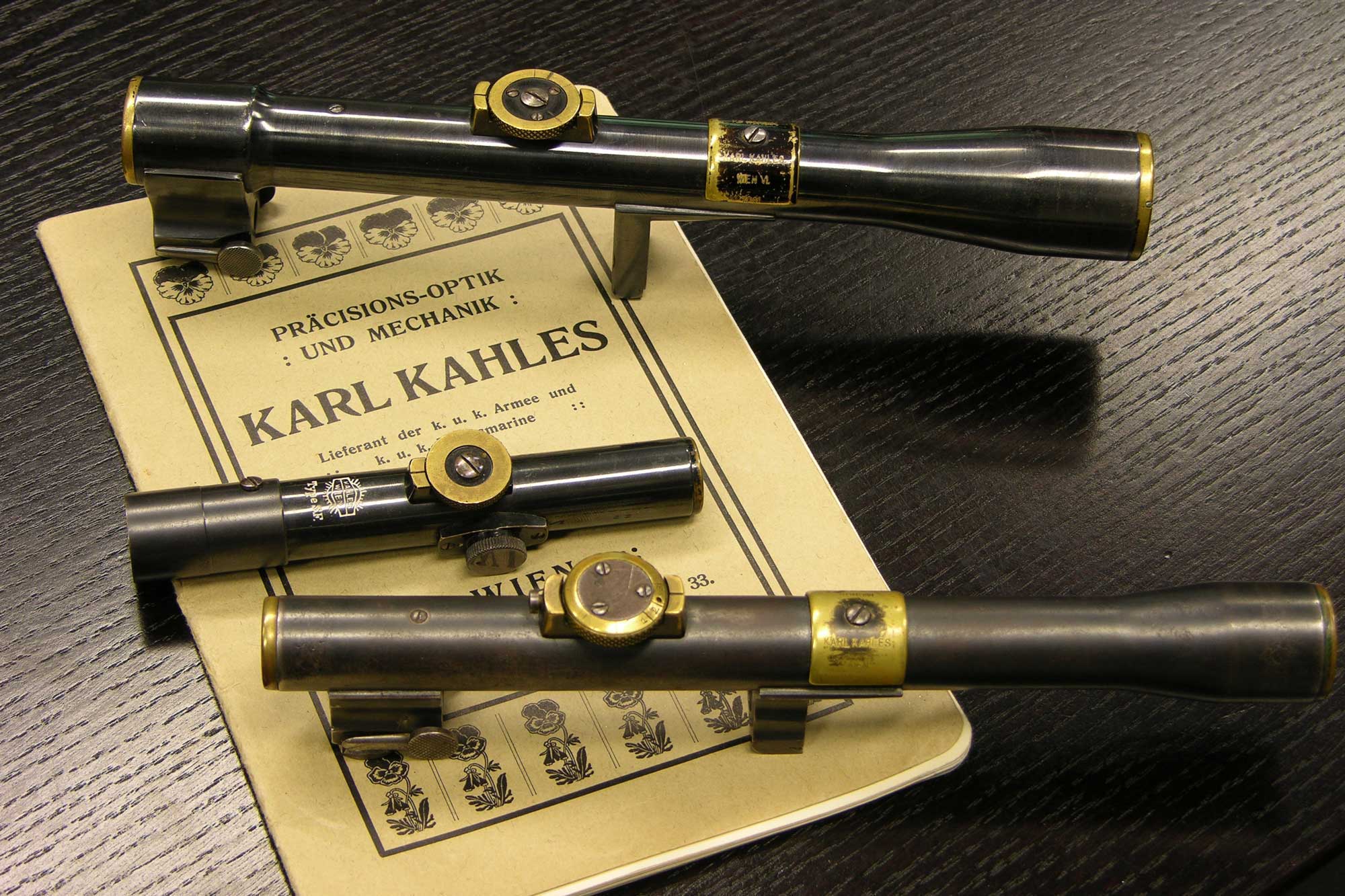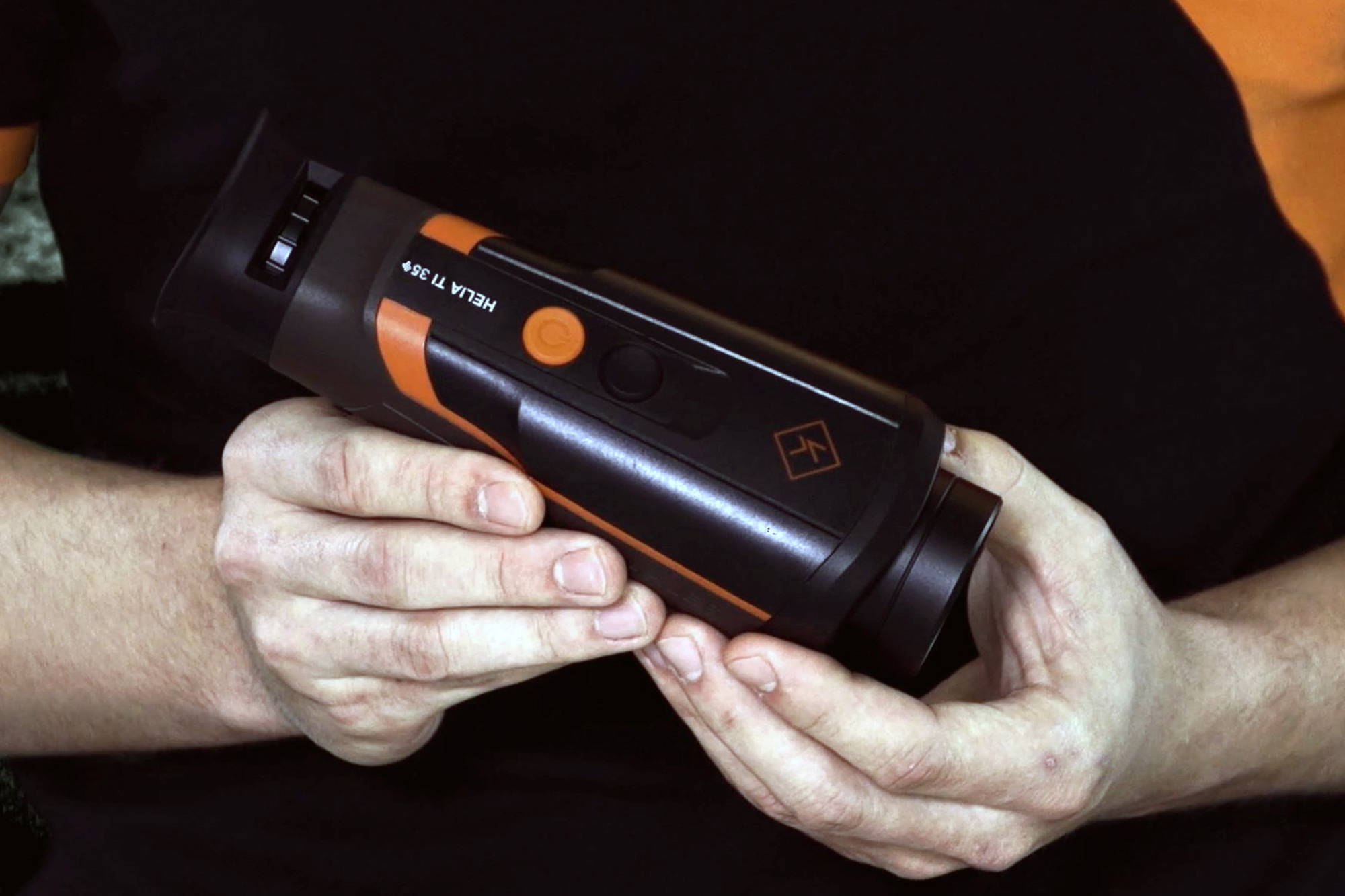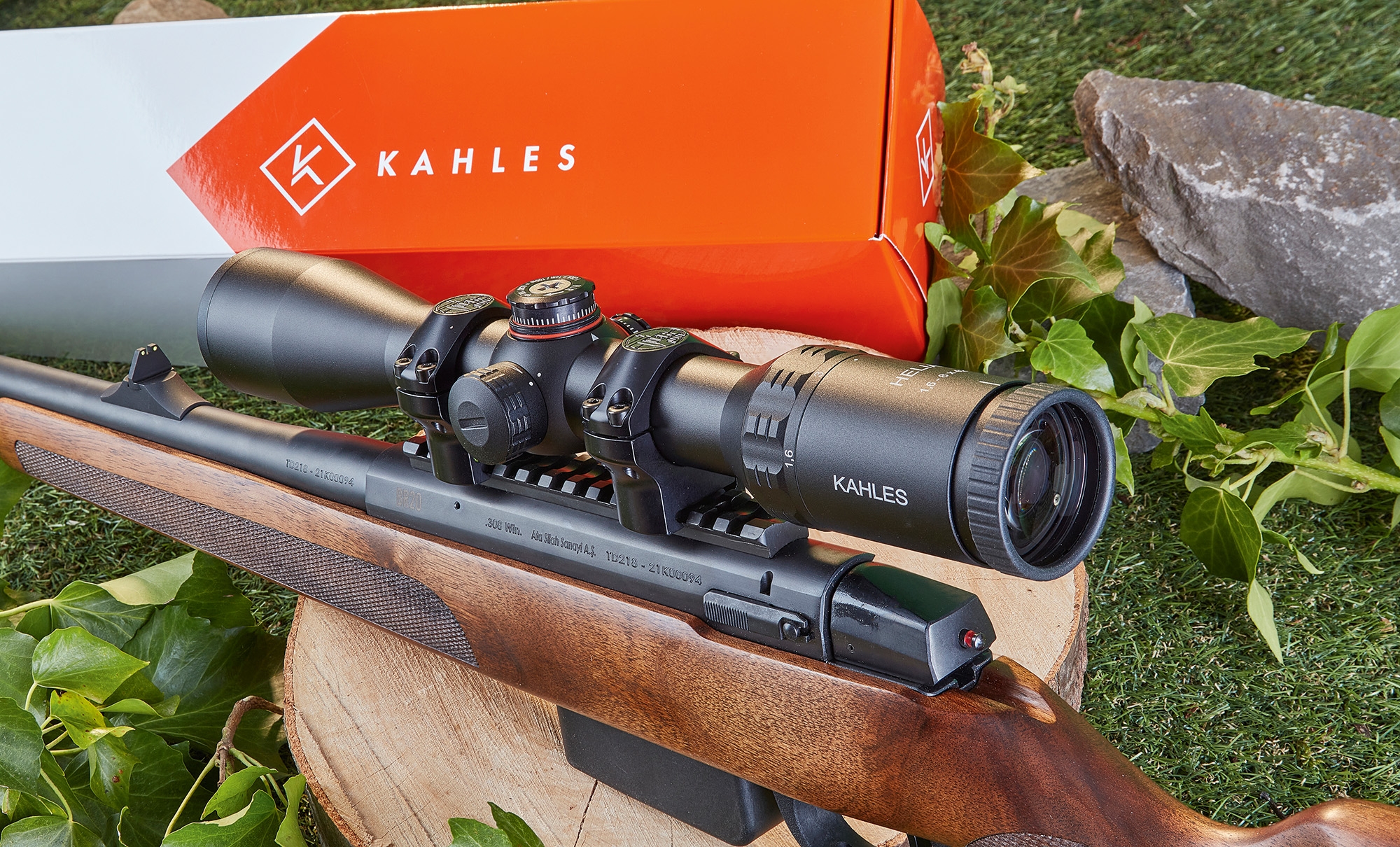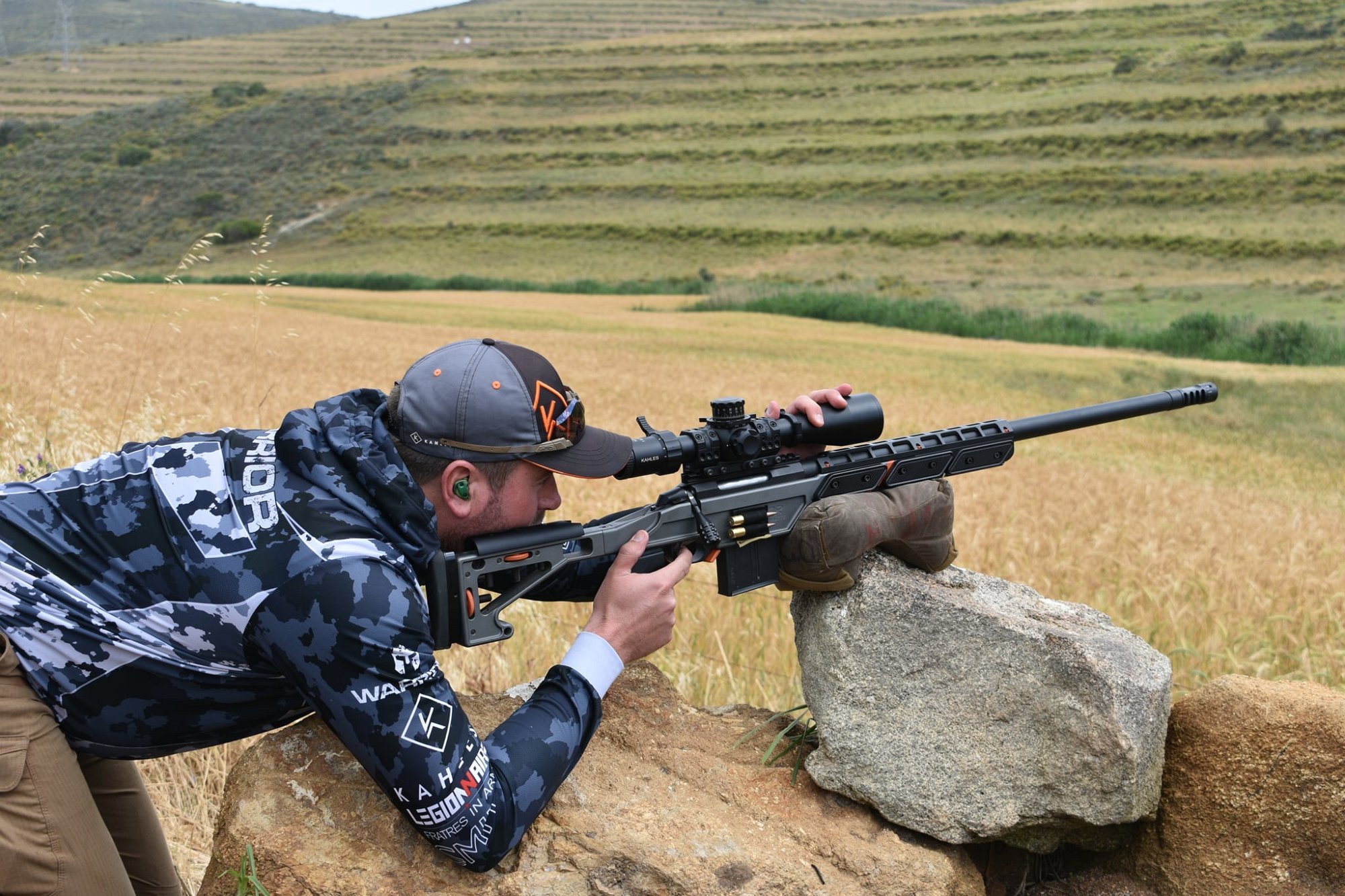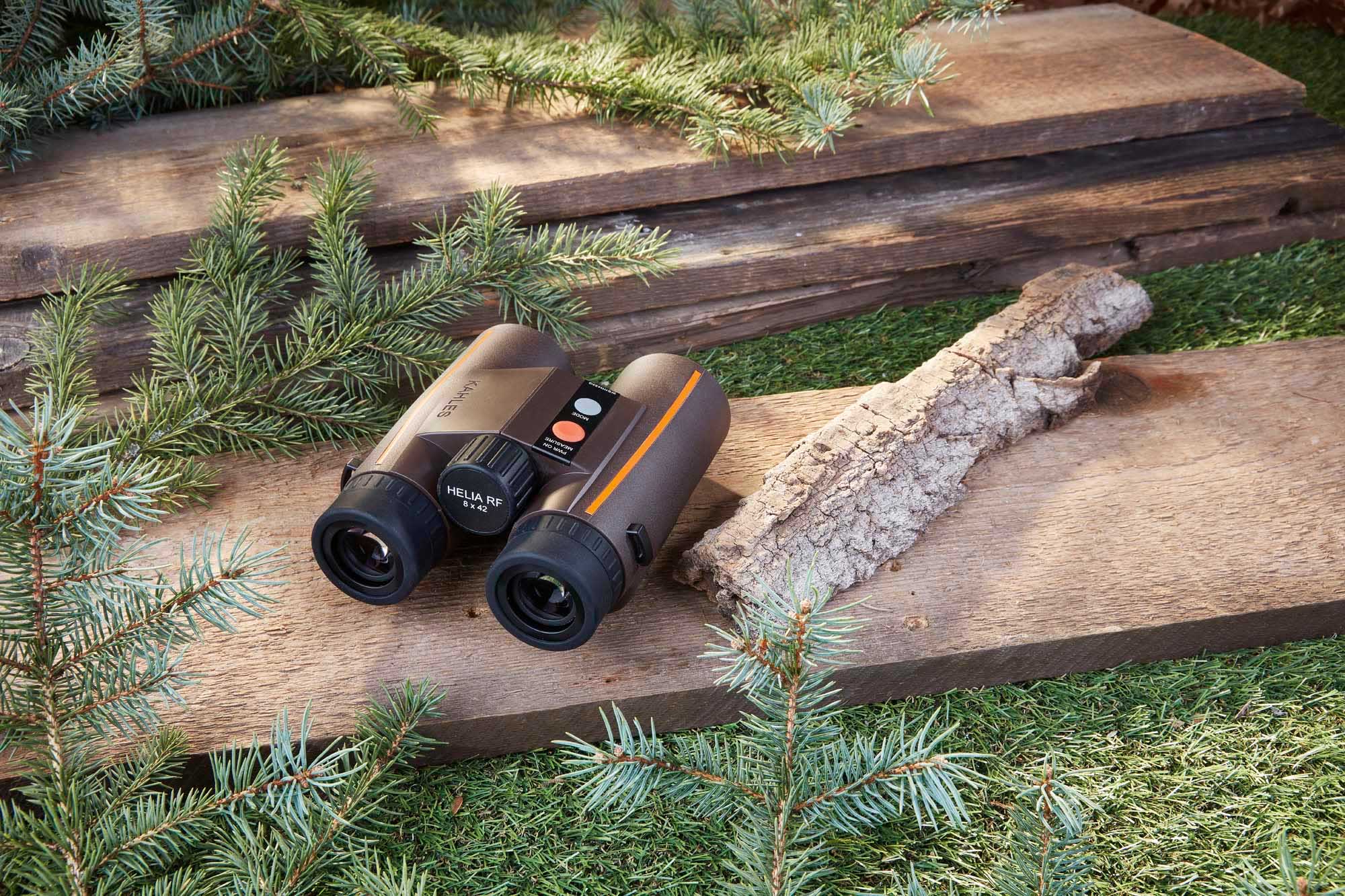Originally introduced in March 2018, the K525i riflescope from Kahles has now been specially adapted for sporting long-range shooting. In the context of the 2021 trade show season, we have already presented the optic on all4shooters.com. Now comes our test: magnification can be continuously adjusted on the eyepiece side from 5x to 25x operating an adjustment ring. This results in a fivefold optical zoom. The windage adjustment turret is optionally available on the left as well as on the right: thus, left or right shooters do not have to reach over the scope for windage reticle adjustment. The elevation turret and parallax adjustment are centered, making them equally easy to reach with the right or left hand. The cover cap of the windage adjustment turret is equipped with a freely rotating "twist guard". This is to prevent accidental adjustment when caught in clothing or when taking aim with the rifle. A small Allen key, housed in the illumination unit lid, allows the turrets to be zeroed and is thus always on board.
The new DLR version of the Kahles K525i in detail
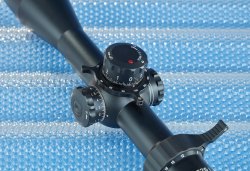
The current version of the K525i, which has been further developed specifically for dynamic long range shooting, goes by the name K525i DLR. DLR stands in fact for "Dynamic Long Range". The main differences in the DLR version include an enlarged field of view for faster target acquisition during dynamic shooting. The K525i has a field of view of 7.1 to 1.5 meters at a target distance of 100 meters, while the DLR has a field of view of 7.7 to 1.6 meters. The first figure refers to a fivefold magnification, the last to the maximum magnification. Larger, and thus faster to read, click settings on the turrets allow the current setting to be captured quickly.
This naturally brings advantages in competition conditions, as you are shooting at various target distances under time pressure. Kahles equips the magnification adjustment wheel with a ring and a long throw lever. This allows the magnification to be changed more quickly, since the entire hand does not have to be placed around the adjustment ring – the lever can be operated quickly and easily with two fingers. The quick adjustment has also been consistently implemented with the so-called "Parallax Spinner" for parallax adjustment. Three small arms, each at an angle of 120 degrees to one another, ensure quick operation of this adjustment ring. Kahles offers a total of seven illuminated reticles on the K525i, all in the first image plane.
The designations are: AMR, SKMR, SKMR4, MOAK, MSR2/Ki, Mil4+ and TREMOR 3. The new DLR variant of the riflescope is equipped with the SKMR4 reticle, which was specially developed for long range shooting. Unlike the K525i, one full rotation of the adjustment turrets on the DLR is exactly one hundred clicks. The turret on the DLR version is also labeled with only one level of digits, rather than two, as on the K525i; this also increases reading speed. The maximum elevation adjustment range is 290 centimeters at 100 m (29 mils). In the case of the DLR, the entire adjustment range is thus distributed over three levels on the elevation tower. The currently set level is indicated by a retractable pin with a red-white-red color marking.
With the Kahles K525i DLR on the shooting range
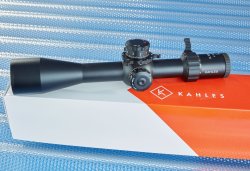
Assessing the optical performance of a riflescope is extremely complex and also requires a great deal of equipment measurement. However, the adjustment of the parallax by means of the adjustment turret provided for this purpose can and must be carried out individually by the shooter. If the parallax is set correctly, the image plane (target image) appears directly on the reticle plane.
A correctly adjusted parallax can be easily checked. If the shooter is looking into the eyepiece at a slight angle, then there should be no offset between the image and reticle planes, since the focus is identical. However, if the two planes are not at an identical axial focus, then an offset will appear when looking into the eyepiece at an angle. The reticle on the target shifts accordingly, even though the rifle with the fixed optics is not moved.
Furthermore, the image appears somewhat blurred at first, especially at high magnifications, due to the axial offset of the two planes. If the shooter looks straight into the eyepiece, the offset is not visible, since both planes are offset to each other, but on the same axis. However, the error can be quickly detected by the oblique view. Therefore, to check whether the parallax is set correctly, it is always advisable to check the parallax by briefly moving the head up and down and sideways: if the reticle remains in the same position of the target image during the head movements, the parallax is correctly set. The frequently marked digits should only be used as a rough guide: parallax-free fine adjustment is made by eye. To do this, the shooter looks straight through the optic and turns the parallax turret until the target image remains absolutely sharp and the crosshairs remain fixed on the aiming point when the eye position is moved up and down or sideways. On the K525i DLR, Kahles marks the parallax wheel with the distances 20, 25, 50, 100, 200, 300, 400, 500, 800, 1000 meters and the infinity position. When checking the parallax, testers were able to set a clear and sharp target image via the parallax wheel at various distances between 23 and 1070 meters each.
The new Kahles K525i DLR in the box test
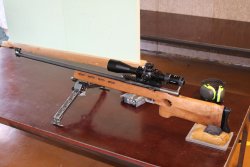
A really meaningful test, which concerns the quality of the adjustment mechanism, can be carried out easily and without much effort by the user himself. This is the so-called "box test". In this test, the rifle is fired at any distance, in this case 50 meters. Once the rifle has been adjusted to the desired distance, the geometric figure known as the box is determined in the form of a square. To do this, a group of three or five is shot at the same aiming point. Then elevation is changed at the elevation turret by, for example, 30 clicks. Now another group is shot.
This process is repeated until the elevation and windage adjustment turrets have been adjusted by 30 clicks each upwards, to the right, downwards and finally back to the left. If the last hit group is found in the first group, congratulations – box test passed. The number of adjustment clicks plays a subordinate role. However, there should be at least 20, so that the distances between the average point of impact of the individual hit groups can be determined more precisely. A small measurement error has less effect if the groups are spaced further apart.
Now use a ruler to measure the distance between the mean hit point of the individual groups. With a click adjustment of 0.1 mil or one centimeter related to a distance of 100 meters, one click corresponds to 0.5 centimeters at 50 meters, so the direct distance of the groups to the above example should be about 15 centimeters with 30 clicks of adjustment. Of course, this test will be more accurate and meaningful the better the combination of gun and ammunition shoots.
Box test result of the new Kahles K525i DLR
The testers therefore used a single-shot match rifle in .308 Winchester with a hammer forged, 762 mm barrel and RWS Target Elite Plus (154 gr) match ammunition. This delivered three-round groupings between 0.236”/6 and 0.315”/8 millimeters from the match rifle. The first and last three-shot group, here logically a total of six hits, resulted in a group of 0.315”/8 mm. Measuring the square shot resulted in a distance between the individual groups of an excellent 5.98”/15.2 to 6.02”/15.3 cm. This test was shot with a new and thus unzeroed scope.
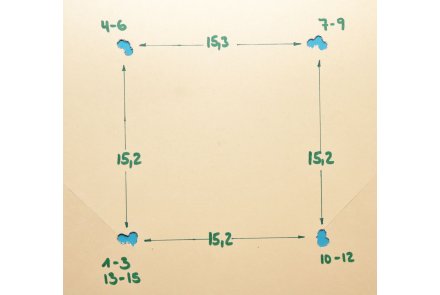
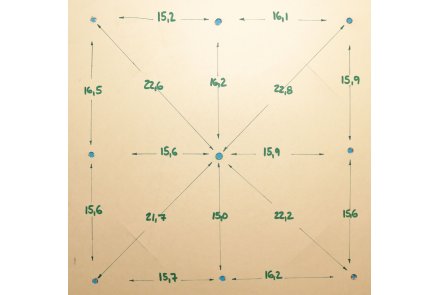
Box test result: Kahles K525i DLR after 600 cartridges in various calibers
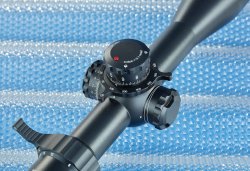
To simulate some aging or use of the optics, the scope was mounted on different rifles in 6.5 Creedmoor, .308 Winchester and .338 Lapua Magnum caliber and a total of approximately 600 rounds were fired. Following this, the Kahles was again mounted on the .308 match rifle and a new, this time more complex, box test was tackled. This time, nine individual shots were fired with one elevation and or windage adjustment after each shot.
The first shot was centered on the target. For shot number two, the scope was adjusted 30 clicks to the right and fired again. Shot three saw a windage adjustment of 60 clicks to the left. Shot one through three were thus on a horizontal plane 30 clicks apart. For shot four, the elevation was adjusted upward by 30 clicks. Shot five and six were each adjusted 30 clicks to the right. Again, this results in a horizontal line of the three shots. For shot seven, the adjustment turrets were adjusted 60 clicks down and to the left.
Shots eight and nine were again each adjusted 30 clicks to the right. Ideally, the distance in the direction of the X and Y axes should be 15 cm each between the bullet holes. For the 5-25x56i DLR, the measurement showed a distance between 5.90”/15.0 and 6.49”/16.5 centimeters. Considering the large adjustment paths and only one fired shot each, these are very good values.
New Kahles K525i DLR long-range riflescope specs and price
| Model: | Kahles K525i DLR |
| Price: | 3550 euro
(price may be different in your country) |
| Objective Lens: | 56 mm |
| Overall Length: | 14.8”/377
mm |
| Main tube: | 34 mm |
| Reticle: | SKMR4 |
| Click
adjustment: | 1 cm /100
meters; 0.1 mrad |
| Elevation Adjustment Range: | 290
cm/100 meters; 29 mrad |
| Windage Adjustment Range: | 30 cm/100
meters; 13 mrad |
| Parallax Adjustment: | 20 m - ∞ |
| Weight: | 34.5
oz/979 g |
Our test conclusion: Kahles K525i DLR CCW 5-25x56
The bottom line is that the new Kahles 525i DLR is a very well thought-out and functional optic for dynamic shooting sports use. The new 2021 model features a clear and sharp image – we were absolutely satisfied. In our opinion, the price of 3550 euros is also absolutely justified for the performance. All the important adjustment controls for the competition are easy and quick to set. A clear and large labeling of the click adjustment and a 100-click adjustment for a full rotation of the turret facilitate the adjustment – even under time pressure in competition. Our box tests show the high repeatability of the adjustments.
What we liked: | What we found less good: |
| Clear and
sharp image | - |
| Ergonomic
and fast adjustment for dynamic disciplines | |
| Great
repeatability in the box test |
Text: Christopher Hocke and Hamza Malalla





